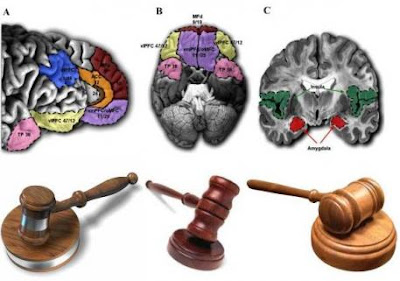Lie Detection and the Jury
Much virtual and actual ink has been spilled of late about the dangers of rushing to bring brain-imaging technologies into the courtroom. Not only neuroskeptics,[1] but also preeminent neuroscientists,[2] have urged caution when it comes to the prospect of fMRI data being admitted as trial evidence. And brain-based lie detection, as one of the most alluring areas of imaging research, has in particular come in for a great deal of hand-wringing.
These portents of doom are perhaps even more premature than would be the use of fMRI “polygraphy” as evidence. Worrying now about that prospect is a bit like throwing out the bathwater before the baby has even gotten into the tub. While it’s true that a few ill-informed judges have made a few ill-conceived decisions along these lines (and those mostly in India, not the United States), the vast weight of judicial precedent, procedure, and practice makes it overwhelmingly likely that courts will move too slowly, rather than too fast, in admitting new techniques of lie detection. As a rule, courts are exceptionally wary of any kind of evidence that they view as usurping the function of the jury, and conventional wisdom has it that the primary function of the jury is to determine the credibility of witnesses. Although most jurisdictions exclude polygraph evidence on the ground that it is not sufficiently reliable, in truth it is at least as reliable as much other “scientific” evidence[4] that is routinely admitted under Daubert,[5] the Supreme Court case that governs admissibility of scientific evidence in the federal courts and the majority of state jurisdictions. But lie detection evidence speaks to witness credibility and thus it is the poster child for usurpation of the jury’s role. While there may come a day when brain-based lie detection becomes so reliable that courts can no longer rely on Daubert to keep it out, history suggests that they will avoid that day as long as they can.
In an article on fMRI lie detection and the role of the jury,[6] I entertained a thought experiment that asked what would happen if fMRI lie detection were to become as reliable as DNA evidence, currently considered the “gold standard” of scientific evidence. If we could easily see whether witnesses were testifying truthfully at trial, would that make the jury obsolete? What, I wondered, were judges so afraid of in opening the door to polygraph and other techniques of assessing witness credibility?
I think the answer goes something like this: Our current criminal justice system hides what the jury does inside a black box. Rules of jury secrecy, combined with rules of evidence and procedure, ensure that most verdicts are unimpeachable on the facts. In other words, so long as there is some evidence against a criminal defendant a reviewing court can (and will) assume that a guilty verdict reflects a jury’s assessment of witness credibility and not, for example, racial bias, failure to follow jury instructions on the law, or even simple mistake. The Supreme Court has written, affirming a conviction in a case involving allegations of extensive drug and alcohol use by jurors during the trial, that “[i]t is not at all clear . . . that the jury system could survive such efforts to perfect it.”[7] Instead, all of the evidence goes into the jury room, it gets shaken up and – abracadabra! – out comes the verdict. If we knew that particular witnesses were lying or telling the truth, it would be much harder to accept certain verdicts without drastically reimagining what it is that we think juries are supposed to be doing.
The Troy Davis[8] provides a depressing example of this dynamic. Despite the claims by advocates on either side of the debate, the evidence [9] in the case was ambiguous and murky. The answer to the question of guilt or innocence depends wholly on which witnesses were telling the truth and which were lying, because it’s clear that someone must have been lying. Since we can’t look into their hearts and minds, we have to rely on some fact-finder to answer this question; in our system, and usually for very good reason, that fact-finder is the jury.
The jury may very well have gotten it wrong. There surely was much reason – in the form of witness recantations and evidence of police pressure – to doubt whether the jury got it right. But in the end, the “reasonable doubt” that many observers urged came from the (very reasonable) suspicion that the main witness against Troy Davis was probably lying. The main problem is that as long as a reviewing court could hold that it was not irrational to believe this witness and to disbelieve the testimony of the defendant, there would be no real basis for overturning the conviction.
In the end, human beings (including jurors) are not very good lie detectors. Indeed, we do little better than a coin flip, though we tend to believe we are very skilled at detecting deception through demeanor and other clues. Though brain imaging based lie detection is still in its infancy, it may someday be capable of supplementing our inadequate abilities in this area. Though we should be cautious – and courts are very cautious – we should also consider the relative reliability of alternative available techniques including that lowest tech of all techniques: the unaided jury. And we should ask ourselves whether it makes sense to enshrine the lie detection role of the jury, in all of its glorious imperfection, at the expense of considering techniques that could help the jury to fulfill this role as well as its other important roles in our system of justice.
--Julie Seaman, PhD
Associate Professor of Law, Emory University
Want to cite this post?
Seaman, J. (2011). Lie Detection and the Jury. The Neuroethics Blog. Retrieved on
, from http://www.theneuroethicsblog.com/2011/11/lie-detection-and-jury.html
[1]http://neuroskeptic.blogspot.com/2009/09/fmri-gets-slap-in-face-with-dead-fish.html
[2] http://www.nytimes.com/2011/11/01/science/telling-the-story-of-the-brains-cacophony-of-competing-voices.html?_r=2&scp=1&sq=gazzaniga&st=cse
[3] http://singularityhub.com/2010/05/06/another-attempt-to-use-fmri-lie-detector-in-us-court-fails-in-brooklyn-more-on-the-way/
[5] http://www.law.cornell.edu/supct/html/92-102.ZS.html
[6] http://papers.ssrn.com/sol3/papers.cfm?abstract_id=1352648
[7]http://scholar.google.com/scholar_case?case=6212097998214052620&hl=en&as_sdt=2&as_vis=1&oi=scholarr
[8] http://www.huffingtonpost.com/2011/09/21/troy-davis-executed_n_975109.html
[9] http://www.gasd.uscourts.gov/pdf/409cv00130_92part1.pdf and http://www.gasd.uscourts.gov/pdf/409cv00130_92part2.pdf





Comments
Post a Comment